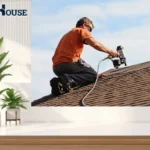Proper roof insulation is like a warm blanket enveloping your home, providing comfort while protecting it from the elements outside. Just as you wouldn’t head outdoors on a cold winter day without bundling up, your home needs insulation to keep heated and cooled air where it belongs – inside.
Installing quality roof insulation brings immense benefits in energy savings, cost reductions, sustainability, and protection for your most valuable asset – your home. This comprehensive guide covers all the key considerations for choosing, installing, and maximizing roof insulation.
Enhancing Roof Insulation for Energy Savings
Effective roof insulation is a crucial component of any energy-efficient home. By creating a thermal envelope to contain conditioned air, insulation can reduce heat loss/gain by up to 50 percent compared to an uninsulated roof. This keeps interiors more comfortable while lowering energy bills.
Beyond the cost savings, insulation protects the physical integrity of the roof assembly against temperature swings, moisture, and air leaks. Proper insulation preserves roof components and structure, avoiding expenses from damage requiring repairs or replacement. It extends your roof’s service life as part of a smart asset management strategy.
Types of Roof Insulation
There are various materials available with different insulating properties, costs, and installation methods:
Fiberglass Insulation
The most common insulation, fiberglass is made of extremely fine glass fibers bonded with thermoset resins. It’s available as batts and rolls to fit between roof joists, or loose-fill for blown-in application.
Spray Foam Insulation
Spray polyurethane foam (SPF) rapidly expands to fill cavities, sealing cracks and crevices. Though more expensive upfront, it offers higher R-values per inch and blocks airflow very effectively.
Rigid Insulation Boards
Rigid panels of extruded polystyrene (XPS) or expanded polystyrene (EPS) serve as weather-resistant external barriers with high stability and R-values. However, gaps can reduce thermal performance.
Structural Insulation Panels
Structural insulation panels (SIPs) are prefabricated boards with rigid foam insulation sandwiched between skins of fiberboard or plywood. Although pricier than other options, SIPs enable thinner, highly insulated roof assemblies.
Radiant Barriers
Radiant barriers are installed facing open cavities to reflect infrared radiation. This primarily reduces solar heat gain in hot climates. Performance is very dependent on installation quality and preventing dust buildup.
Each insulation type carries unique advantages shaping appropriate applications. Compare density, R-values per inch, moisture resistance, environmental factors, and installation requirements during decision making.
R-Values for Roof Insulation
R-value indicates an insulating material’s capacity to resist conducted heat flow. It’s measured as R per inch thickness.
Higher R-values provide greater insulation performance – critical for roofs where extreme temperature differentials cause substantial conductive gains/losses.
Most U.S. states follow International Residential Code (IRC) guidelines recommending minimum R-values for residential roofs based on regional climate conditions.
| Climate Zone | Recommended Minimum R-Value for Roof Insulation |
|---|---|
| 1 (Southern U.S.) | R-30 |
| 2-8 (Central and Northern U.S.) | R-38 |
For maximum efficiency and savings, the DOE advises reaching R-49 up to code allowance limits, especially for existing homes without insulated sheathing. Calculate total R-value by adding all layers – existing plus new.
Utilize DOE calculators accounting for your structure and climate to tailor insulation recommendations.
Benefits of Good Roof Insulation
Quality roof insulation directly translates into:
Energy and Cost Savings
The EPA determined upgrading insulation across all U.S. homes to current standards could net annual heating/cooling savings of 4.7 quadrillion BTUs nationally!
With strong attic insulation helping regulate interior temperatures, your HVAC system doesn’t labor as hard. You can lower thermostat setpoints in winter and raise them in summer, reducing runtime and energy consumption.
Most homes see heating/cooling cost reductions of 10-50% following insulation upgrades. Detailed calculations should account for climate, utility rates, building characteristics, and materials used.
Long-Term Prevention of Damage
Roofs endure heavy weatherization from sun exposure, precipitation, freeze/thaw cycles, expansion/contraction, and moisture infiltration. Temperature and humidity fluctuations accelerate decay of vulnerable framing and sheathing.
By moderating roof deck temperatures across changing conditions, proper insulation preserves structural integrity and stability. This avoided deterioration helps roofs last their intended lifespans.
Sustainability and Environmental Benefits
Increased building insulation is widely recognized as one of the most impactful interventions for ecological building operation. Boosting U.S. insulation would lower associated emissions by nearly 10%!
On an individual home basis, lowering your energy use prevents substantial carbon pollution associated with electricity or gas consumption. This lightens your environmental footprint.
Added Protection for Your Roof
Insulation blocks conductive heat transfer into underlying assemblies. On hot summer days, uninsulated attics can reach 160-180°F! This extreme radiant heat bakes vulnerable shingles and accelerates failures.
Quality insulation keeps roof decks significantly cooler while also inhibiting condensation that erodes integrity from the underside. This protective blanket sustains your roof’s health.
Factors Affecting the R-Value of Fiberglass Insulation
As the most common residential insulation, fiberglass offers many desirable qualities. However, its real-world performance depends on several variables:
Fiber Density
Higher density fiberglass (more glass per square inch), increases resistance to conducted heat flow. Density reductions above certifications like 16 pounds per cubic foot can decrease R-Value by 10-20%.
Material Degradation
Humidity, moisture, and compression over time can diminish fiberglass insulation capacity. Condensation causes fibers to lose loft and insulative air pockets. Check for visible degradation before installing over existing fiberglass.
Air Infiltration and Ventilation
Heat convection via airflow accounts for 25-40% of home energy loss. Gaps between insulation and framing rapidly lower effective R-Values. Likewise, attic ventilation absolutely requires accompanying air sealing.
Impact of Colder Temperatures
Fiberglass insulation loses R-Value in extreme cold. Around 0°F, R-13 insulation only provides about R-10 insulation capacity. In very cold climates, increase fiberglass depths or supplement with rigid foam boards.
Carefully addressing these factors ensures fiberglass insulation performs as rated over the long term.
How to Choose the Right Roof Insulation
Refer to the following considerations when selecting roof insulation:
Climate Zone: Determine the recommended R-Value for your region and tailor insulation accordingly. Prioritize higher R-Values in extreme climates.
Application: Match insulation to intended installation method (exposed, enclosed cavity, etc.). Factor expected mechanical wear and moisture contact.
Existing Insulation: Assess current insulation condition and R-Value when deciding on adding new material versus replacing.
Cost: Compare insulation cost per R-Value in addition to total project expense. Dense-pack cellulose or polyurethane foam offer best value long-term.
Project Scope: If working on multiple building thermal envelope updates beyond the roof, determine phasing and synergistic effects between improvements.
For do-it-yourself insulation projects up to R-30, fiberglass batts are fairly straightforward to install. Spray foam, rigid foam boards, or dense blown-in loose fill applications often require hiring professional insulation contractors for best results.
Carefully model costs beyond just insulation materials, accounting for additional accessories like weatherization, adhesives, fasteners and labor if not self-installing.
How to Install Roof Insulation
Follow these best practices to apply roof insulation:
- Air seal all penetrations, cracks, and openings with caulk and expandable foam prior to installing insulation. Eliminate airflow convection which saps insulation capacity.
- Inspect and patch any leaks or deterioration on roof deck and underlayment where insulation will contact.
- Calculate the required insulation depth using AFUE coefficients to reach recommended R-value based on your climate zone, adding thickness to existing insulation as applicable.
- Cut insulation panels for friction fit installation between rafters and joists where needed.
- Use mechanical fasteners or adhesive to tightly bond insulation against roof deck without gaps.
- Extend insulation fully over top plates of exterior walls adjacent to unconditioned spaces for proper encapsulation.
- Have official inspection for fire safety codes and minimum R-value compliance as required based on insulation type and application method in your area.
Proper installation is vital – improperly applied insulation loses up to 50% of real-world effectiveness due to compression and air pockets.
Other Ways to Improve Energy Efficiency in Your Home
While proper roof insulation is the most direct way to regulate conductive heat transfer, a whole-house approach to efficiency upgrades can maximize energy savings. Evaluate improvements across these areas in tandem:
1. High-Performance Windows
Windows represent another key area of heat loss/gain, with higher R-values than walls. Older single-pane models lose substantial energy through the glass and air leaks.
Replacing deficient windows with new double or triple-glazed options featuring:
- Low-emissivity (low-E) metallic coatings to reflect infrared heat
- Inert gas fills (argon, krypton) to reduce conduction
- Thermal breaks within frames to limit transfer
- Insulated spacers between panes
Can reduce wasted energy by 25% or more. Prioritize upgrades in rooms with the most extreme hot/cold exposure.
2. Smart Thermostats
The capabilities of smart thermostats have increased dramatically. Models like the Nest Learning Thermostat utilize:
- Occupancy sensing to set back temperatures when empty
- Activity monitoring to recognize occupied hours
- Multi-stage HVAC control rather than simple on/off
- Weather data and algorithms to optimize runtime
With connected apps and voice assistants, users easily program optimized heating/cooling schedules relative to usage patterns and local climate. This hands-free convenience increases compliance.
Studies on modern smart thermostats show average energy savings of 5-15%. Paybacks on hardware costs typically occur within 2 years.
3. Ceiling Fans
Many homeowners overlook simple ceiling fans. But strategic use with your HVAC system can make a measurable difference, using the same energy as a standard light bulb!
During summer, run ceiling fans to circulate cool air without adjusting your thermostat below 78°F. In winter, reverse direction for gentle updrafts that break up cold air stratification so you can set the thermostat lower.
Permanent 2-4° temperature adjustments represent savings of 8-15%. Fans also allow intermittent thermostat setbacks of 5° or more since their airflow rapidly rebounds your preferred ambient level once heating/cooling resumes.
Coordinate across all of these opportunities for maximum energy and cost reductions specific to your home’s needs and regional weather.
Conclusion
Installing roof insulation brings compounding rewards – reduced energy costs, smaller carbon footprint, extended roof lifespan, and protection for your home’s structural integrity over time.
This guide addresses key considerations around regional recommendations, insulation types, real-world performance variables, project scoping, DIY installation, and whole building efficiency.
Following these research-backed best practices for insulating your roof will pay comfort and cost dividends for years to come. Your cozy, energy-efficient home starts from the top down!




